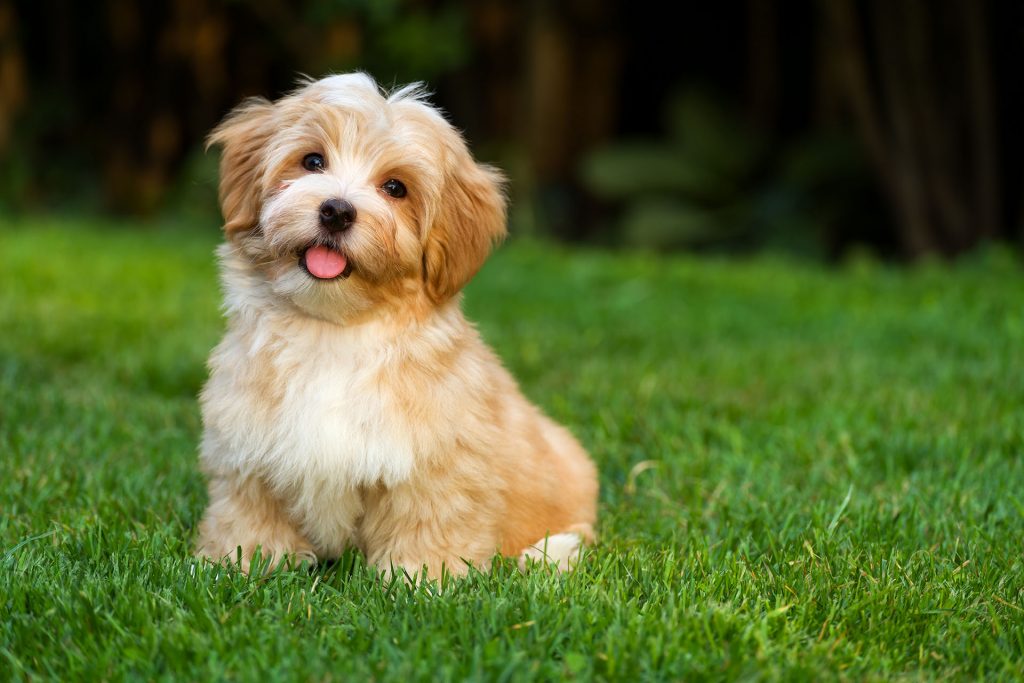
A beautiful lawn is like an extension of your living room.
It’s a great place for the family to hang out, relax, eat, and play all summer long.
And if your family includes pets, they’ll love it, too.
But if you have a family dog, you may find an unfortunate side effect of your dog’s love for your lawn: urine spots.
As any dog-owning lawn enthusiast knows, dog urine can cause unsightly burn marks on your lawn, so what can you do to prevent dog urine spots on your lawn?
The good news is that it’s not hopeless.
You can protect your lawn and prevent dog urine spots with a few simple steps
What Causes Dog Urine Spots?
There are a lot of myths about dog urine and its effect on turfgrass.
We’ll get to debunking some of those myths in a little bit.
But first, we need to talk about what causes those spots in the first place.
Many people hear lawn experts refer to dog urine as “burning” grass and assume we are referring to pH.
In fact, it is something much simpler.
Dog urine contains a lot of nitrogen. While nitrogen is usually a good thing for your lawn—it is the main ingredient in most fertilizers—too much of a good thing can be bad for your grass.
Concentrated nitrogen can “burn” and kill your grass.
However, this nitrogen overload also helps explain the distinct appearance of dog urine burn spots.
Urine spots often start as dark green patches.
That deep green color is the result of heavily fertilized grass.
Eventually, especially if your dog continues to pee in the same spot, you may end up with a dead patch of grass surrounded by a dark green ring.
The dead patch is where the high concentration of nitrogen has killed the grass, and the dark ring is where the urine is less concentrated and the grass is vigorously growing.
In addition to too much nitrogen, another cause of dog urine spots is the high level of salts in your dog’s urine.
The salts dry out the grass, and the plant becomes so desiccated that it dies.
You’ll notice yellow or brown patches of dead grass on your lawn when that happens.
Even then, you may still see a green ring around the spot.
That’s where the concentration of salts was lower, and the nitrogen increased growth.
Dealing with Dog Urine Spots
There are two ways of dealing with dog urine spots.
Essentially, you can either prevent or treat the spots.
To prevent them, you have to change your cultural practices and your dog’s behavior.
If the spots are already there, treating them is similar to recovering from any damage to your grass.
Prevent Spots
You need to get to the root of the problem to prevent dog urine spots.
The cause of the spots is an overload of nitrogen and salts from the urine.
To avoid damage, you need to disperse and dilute the nitrogen and salts.
Luckily, that’s not hard to do.
Flushing the area where your dog just peed will help minimize the effects of the urine, as the harmful compounds are washed away.
In the most extreme sense, this might mean that you follow your dog around outside when they are doing their business.
After the dog relieves itself, flush the spot with plenty of water.
Alternatively, you can make sure your grass gets a regular watering to flush out any spots.
Typically, we recommend deep waterings on a more spread-out schedule. But more frequent shallow watering can help prevent nitrogen and salt overload if you are dealing with dog urine spots.
If you have a smaller dog, there may not be enough urine to actually kill the grass.
Instead, your lawn problem may just be an unsightly patchwork of dark green dots.
If that’s the case, you can try to blend in the spots by keeping the entire lawn well-fertilized.
The spots won’t show up if your whole lawn is deep green.
Another way to prevent spots is to train your dog to go in one spot off your grass or in an unnoticeable area of your lawn.
Various products can help. For instance, some pet stores sell posts impregnated with pheromones to attract dogs and make them pee on them. Basic dog training is also possible.
Take the dog on a leash to do their business in the preferred spot, then reward with verbal praise and treats.
After a couple of weeks, you may find your dog going to that spot to do their business even without a leash.
Treat Spots
If you’ve already got dead spots from dog urine, it’s too late to use prevention methods.
Instead, you need to deal with the damage and repair the dead spots.
For the most part, dealing with dead spots in your garden is the same, whatever the cause is.
The first thing to do when repairing a dead spot is to remove the dead grass.
Use a metal take to pull up the dead grass and remove it.
Once the grass is gone, it’s time to treat the soil.
Since the grass died from too much nitrogen and concentrated salts, it’s a good idea to flush the area with water to clear the soil.
After that, you have three choices for repairing the grass.
The first option to fill in an empty spot is to lay down new seed.
Use the same seed as the rest of your lawn, and follow the directions that come with the seed.
Make sure to water generously and keep off that part of the lawn until the grass is established.
The second option is to place new sod in the dead patch. Make sure you start with healthy topsoil, then lay the sod.
Again, stay off the new sod until it is well established.
If the spot isn’t too large, the third option is to wait for the grass to fill in the dead spot with new growth.
Bermuda grass and zoysia grass are creeping grasses, which means they are spread by above-ground stems called stolons and underground stems called rhizomes.
Both types of grass can fill in small spots relatively quickly, without much intervention.
Start with Strong Turf
Healthy turf will hold up better against any pest – even if that pst is your sweet pup.
Thus, starting with a hardy turf type and keeping your lawn well-watered and fertilized can do a lot to fight dog urine spots.
Zoysia is a dense grass that does well against the added traffic of dog paws – and urine.
It’s durable and doesn’t require as much water as other turf types.
Additionally, though it’s not fully “urine spot-resistant,” dog urine will not kill the grass. The zoysia grass will come back.
The Bottom Line
If you have a dog, you may have to deal with urine spots on your lawn. However, it is not inevitable.
You can train your dog to do their business in a specific spot, minimizing damage to your lawn.
Adult male dogs often cause fewer spots because they don’t usually pee in a concentrated pool. Instead, they wander your yard, using bursts of urine to mark their territory.
But if you have a puppy, an older dog, or a female, you will likely have at least some trouble with urine spots. Luckily, they are treatable.
And remember, as much as you love your lawn, your dog is an important part of your family, and they won’t be around forever.
Sometimes, taking a step back and looking at your priorities is the best way to deal with dog urine spots.
Lawns can be repaired. Work with your dog to reduce spots, but keep in mind the value of your relationship with your pet.
As we often point out, the healthiest lawn is most able to deal with stress and recover from minor damage.
Starting with quality turf from The Turfgrass Group is the best thing you can do for your lawn.
Try any of our varieties. You can find a certified local grower here.
FAQs
Why does dog urine cause burn spots on the lawn?
Dog urine contains a high concentration of nitrogen, which, when concentrated in one area, can “burn” and kill grass. Additionally, the salts in the urine contribute to drying out the grass, resulting in yellow or brown patches.
Can urine spots on the lawn be prevented?
Yes, urine spots can be prevented by diluting and dispersing the nitrogen and salts in the urine. Methods include flushing the area with water immediately after the dog urinates, regular deep watering, and training the dog to use a specific spot or area.
Are there products to train dogs to urinate in a specific spot?
Yes, some pet stores offer posts impregnated with pheromones to attract dogs and encourage them to urinate in designated areas. Basic dog training, using rewards and positive reinforcement, can also be effective in training dogs to use a specific spot.
What should I do if my lawn already has urine spots?
If urine spots are already present, you need to deal with the damage. Remove dead grass from the spot, flush the area with water, and choose from options like laying new seed, placing new sod, or allowing the grass to fill in naturally.
Is Zoysia grass resistant to dog urine spots?
While not fully “urine spot-resistant,” Zoysia grass is dense, durable, and able to recover from dog urine damage. It withstands added traffic and requires less water than other turf types, making it a good choice for lawns with dogs.
How soon after my dog urinates should I flush the area with water to prevent spots?
It’s best to flush the area with water immediately after your dog urinates. This helps to minimize the concentration of nitrogen and salts, reducing the potential for grass burn spots.
Can certain grass varieties resist or recover better from dog urine damage?
Zoysia grass is known for its resilience against dog urine damage. While not entirely resistant, it recovers well and withstands the impact of dog paws and urine, making it a preferred choice for dog-friendly lawns.
Are female dogs more likely to cause urine spots than male dogs?
Female dogs, especially those that squat and release urine in a concentrated area, are more likely to cause urine spots. Adult male dogs tend to mark territory by urinating in bursts across larger areas, reducing the risk of concentrated damage.
Is there a recommended watering schedule to prevent dog urine spots?
While deep watering on a regular schedule is generally recommended, more frequent shallow watering can help prevent nitrogen and salt overload in the case of dog urine spots. Adjust watering based on the specific needs of your lawn.
Aside from urine, can other pet-related factors impact the health of my lawn?
Yes, factors like pet feces, digging, and heavy paw traffic can affect your lawn’s health. Cleaning up pet waste promptly, filling in holes, and managing foot traffic can contribute to maintaining a healthy and green lawn.
